Hollywood created an illusion with performers becoming stars who were recognised world wide. The movie musicals offered a glimpse of Broadway well beyond the streets of New York. The sale of gramophone recordings also made stars out of singers, musicians and bands. Much of this conveyed American culture to the world, which was a big influence on our behaviour by causing us to follow these overseas trends.
Amateur theatre went professional when the Repertory Club evolved into the National Theatre Company at the Playhouse Theatre.
Locally, the Edgley family had a big influence on theatre and the early days of television by partnering stage productions and arena events with TVW Channel Seven.
Television soon became the dominant influence on our everyday entertainment needs.
Theatre restaurants and cabaret bloomed as TV and theatre folk moved into the hospitality field.
Music and dance has had a big impact on our culture and what is considered acceptable behaviour. For example, there was a time in history when the Waltz was considered improper for the close contact with one’s partners body, which contrasted sharply with the stately dances of the aristocracy – the minuets, polonaises, and quadrilles – in which one kept one’s distance. the Oxford English Dictionary shows that it was considered “riotous and indecent” as late as 1825. How those notions were to change a century later when the dance floor witnessed the tango, foxtrot and the Charleston. It was to get another big shake up with the introduction of the jitterbug whilst dancing to swing music, and its lively and uninhibited variation called “Jive”, which in the 1930s and 1940s was also an expression denoting glib or foolish talk. By the late 1940s and early 1950s there was a further incarnation that evolved called Rock ‘n’ Roll.
At each step of the way there was pressure from elders wishing to impress their values on the younger generations. Obviously they did not succeed otherwise we would still be wearing hats and suits in the Australian summer and women would be wearing long Edwardian dresses and still lining up one side, and men the other, at dance halls. The modern DJ in a discotheque, music, dance styles and modern fashions are a world apart.
A lot of people went to the Embassy Ballroom in the late 50s and early 60s where the policy was half modern and half old time dancing. Jive was not allowed on Friday, or Saturday night, as the traditionalists “wanted to keep it nice”. Much of the old time was sequence dancing, which was a lot older than modern ballroom dances.
Old-time included the Circular Waltz, Country dance, Quadrille, Galop, Polka, Saunter, Gavotte, Two Step, Mazurka, Schottische, Cakewalk, Pride of Erin and many more.
Modern dances include the Modern Waltz, Tango, Foxtrot, Quickstep and Viennese Waltz.
Latin-American dances have also become popular in the ballroom with the Rumba, Cha-cha-cha, Samba, Jive, Paso Doble, Bossa Nova, Salsa and Mambo.
Dances that were all featured in Channel Seven’s “Invitation to The Dance”, which was produced and directed by Brian Williams, with Sam Gilkison as his associate producer in 1963. This one off special involved the Perth dance studios and dance community at that time. The prominent ballroom dance studios were the Gilkison and the Wrightson dance studios.
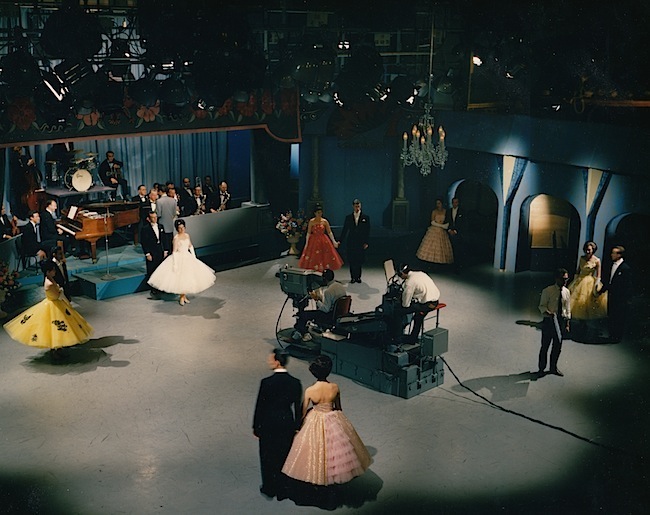
All dances in ballrooms were sequence dances until the early 20th century. The movie musicals featuring Fred Astaire (1899–1987) and Ginger Rogers, with whom he made ten films, and a number of others with partners such as Eleanor Powell, Rita Hayworth, Cyd Charisse, Leslie Caron and Audrey Hepburn, increased the popularity of modern ballroom dance forms. Big musical influences in his films were George and Ira Gershwin, Cole Porter, Irving Berlin, Harold Arlen and Johnny Mercer. Music which also populated the Perth radio airwaves.
Not all the big Broadway stars made their way to Australia, though promoters often brought the shows out, even if Australian performers filled the roles. Movie musicals had a big impact as the large audiences absorbed the American dance culture, with gramophone recordings and the playtime they got on radio being an important source of American music culture, until the advent of television.
Before Rock ‘n’ Roll, Crooners at the time were the dominant popular vocal style remembered by the voices of Bing Crosby (1903-1977), Frank Sinatra (1915-1998), Perry Como (1912-2001) and others. It was a time when the radio stations played everything from late 19th century operettas, to the popular music of the day, including Nat King Cole, Doris Day, Frankie Lane and Glen Miller.
Crosby’s singing style influenced many of the popular male singers who followed him. He began by playing drums in his high school’s jazz band and listened to all the hot records at the music store. During his youth, his singing idol was the singer, comedian, and actor Al Jolson (1886–1950). A road trip with musical friends gave him much exposure to the popular musical styles during the prohibition of alcohol era from 1920 to 1933 in the US, which gave him and his friends an opportunities to play and sing in establishments that illegally sold alcoholic beverages. Particularly the higher-class speakeasy… the popular venues that offered food, drink and entertainment.
Establishing himself as a big band singer, Crosby’s popularity escalated from 1934 to 1954 as he crossed over from recording music to radio and television shows. Being a leader in not only record sales, but radio ratings and motion picture grosses. He became one of the best-selling recording artists of the 20th century. He recorded more than 1,700 songs, appeared on 4,000 radio shows, in 100 movies, and on 300 television shows. He was to be rivalled only by Elvis Presley and the Beatles.
Crosby’s trademark bass-baritone voice paved the way for the pop vocals movement which caused a revolution within the Australian Broadcasting Commission, which had tended to prefer music of a more classical nature. Local singers and musicians were greatly influenced by overseas trends, with Perth artists emulating the styles as they followed the popular movements in music.
Interestingly, when Max Bostock was auditioning acts for television, he found that miming hit records was an early trend in WA for hopeful performers, rather that having the singing skills to carry the tune. Some comedy acts on “Spotlight” were particularly entertaining in this fashion, though later the miming of popular hits songs of established artists gained use on “Club 7 Teen” in 1967, to demonstrate the hit parade.
One of the popular show bands of the 1950s was the Norm Wrightson Dance Band where Jack Harrison played clarinet. He was also to play for the Western Australian Symphony Orchestra (WASO).
Throughout the early 1950’s, the music of the big band era still reigned until the mid-1950’s, when performers such as Elvis Presley, Chuck Berry, Little Richard, Ray Charles, and Jerry Lee Lewis attracting the attention of youthful audiences. This was triggered by the the advent of Rock ‘n’ Roll, first popularised by Bill Haley and his Comets with “Rock Around The Clock” released in 1954 in New York and elsewhere in 1955, this injected new zest into the dance and music scene and was particularly evident when the 1956 movie “Rock Around The Clock” was screened in Perth in 1957.
Interestingly, a few years earlier in 1952, that Elder, Smith and Co. Ltd. obtained an order for repossession of the ballroom from the Embassy Cabaret Pty. Ltd.
Elders core business was as a trading company and commission agent for wool and other agricultural products for sale back to Britain. The company owned Temple Court and needed more office space so after a compromise arranged by the State Premier, the Embassy Cabaret continued in its role as a public ballroom to a modified extent, although the whole of the former supper-room on the floor below was turned into offices.
The Coca Cola Hi Fi Club Hops at the Embassy Ballroom started in 1959 and ran until 1963. This was run by 6KY announcer Colin Nichol, who was also President of the local Club, which enjoyed an attendance of about 1,000 until there was competition from Canterbury Court, which ran gigs at the same time.
These Coca Cola Hi Fi Club events coincided with the beginning of television in Western Australia. Prior to this, many of the hotels had talent quests in the 1950s and bands not only had the Embassy and Canterbury Court, but also the Cottesloe Civic Centre, Government House; and Romano’s and La Tenda Night Clubs to perform.
Another venue located in South Perth, which started in 1922 as the Pagoda Chinese Tearooms, became popular as a ballroom after the second world war. It was also used over the years for roller skating, jazz music and weddings, to now be restored and known as the Pagoda Restaurant and Bar.
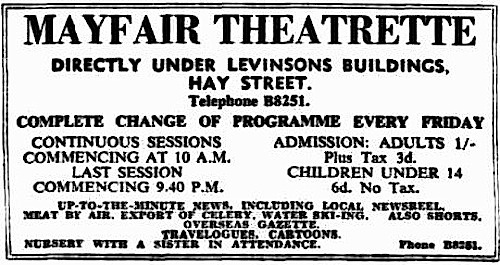
In 1947, the Mayfair Theatrette opened in Hay Street showing newsreels and short films. It was built by Joel Moss in the basement of Sheffield House, under Levinson’s, in Hay Street. When the newsreel distributors refused to supply Moss with the Cinesound Review and Movietone News, he decided to produce a local newsreel, with Leith Goodall as chief cameraman, until Cinesound Review was offered to the Mayfair. The Mayfair closed on 25 May 1968, suffering from the impact of television to re-open on 10 June 1968, as the Cinema Capri then showing feature films until it closed in September 1987. The Mayfair sat between two earlier cinemas, the Pavillion (1914-1930) at 709 Hay Street and the silent film only cinema the Palladium (1916-1926) at 723 Hay Street. Leith Goodall’s sons Peter and Michael continued in the same field, but as News cameramen for television.
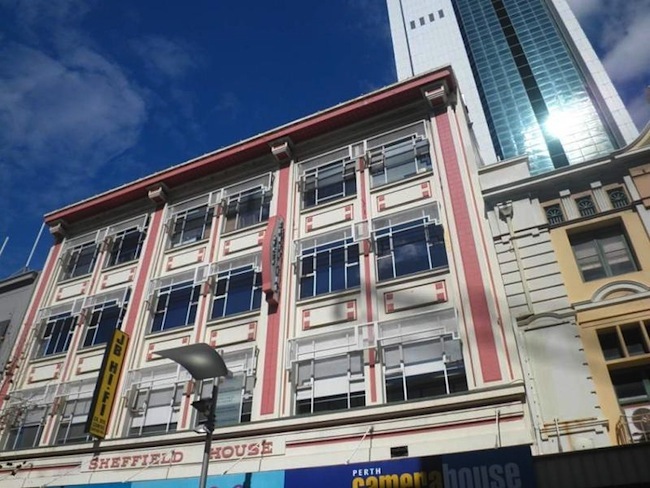
The architect George Thomas Temple Poole (1856-1934) and C.F. Mouritzen built Sheffield House at 713 to 721 Hay Street Mall, in Perth, and also built the Capitol Theatre and Temple Court at the foot of William Street. Sheffield House is a majestic Inter-War Chicagoesque building that is part of an important collection of historic buildings facing on to the Hay Street Mall.
The Heritage listed building was occupied by W. Richards Engineer in 1918-20, Harrison & Co, Manufacturing Agents in 1921, C. M. Finlayson Dress-cutting and Paulines Milliners in 1922-25, Levinson & Sons Jewellers, Watchmakers & Optometrists in 1926-49, the Carlton Club Dining Rooms in 1927-46 (Basement) – Mayfair Theatre (Basement) in 1947-68, Cinema Capri (Basement) in 1968-87. The basement is now occupied by JB HI FI. There has been considerable layout modification, where the basement no longer resembles the former cinema auditorium.
At the end of the 1940s, a once unsightly area that was little more than a sandpit was terraced to seat an audience facing the Shann Memorial at the University of Western Australia, which was flanked by two lily ponds and an arched rustic bridge. It was cleverly transformed from a quarry, used for the construction of the Hackett Memorial buildings, to a secluded amphitheatre with gardens, ponds and terraced lawns.
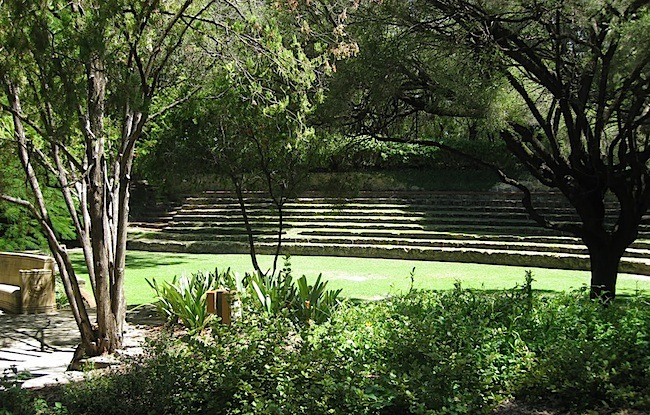
The Sunken Garden at the University of Western Australia
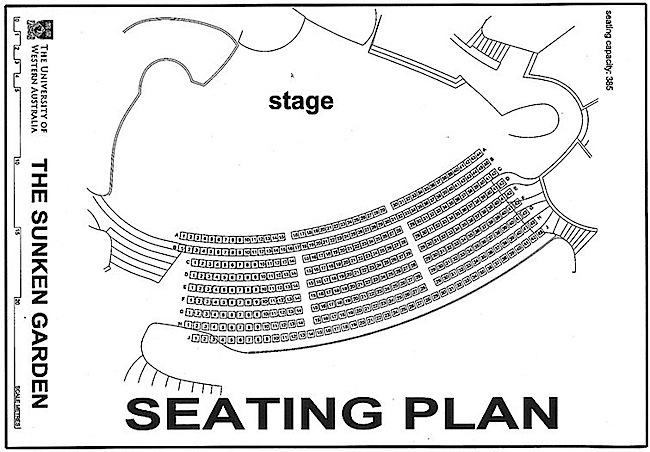
Sunken Garden Seating Plan
The new venue became known as the Sunken Garden and was first used for a theatrical production of Oedipus Rex in 1948, which earned the plaudits of Laurence Olivier and Vivienne Leigh among others. Jeana Bradley of UWA was the director.
In 1951, the Gilbert and Sullivan Society of Western Australia was established with the first production being H.M.S. Pinafore, held at the Assembly Hall in Pier Street from April 30th to May 9th, 1953. Bernard Manning, a professional performer trained in England, was instrumental in forming the society, in which he played an active role in ensuring the Society’s success for the next 10 years, until he died on May 5th, 1961.
It was also in 1951 that ‘Edgley’ and ‘Dawe’ moved to Perth to manage His Majesty’s Theatre.
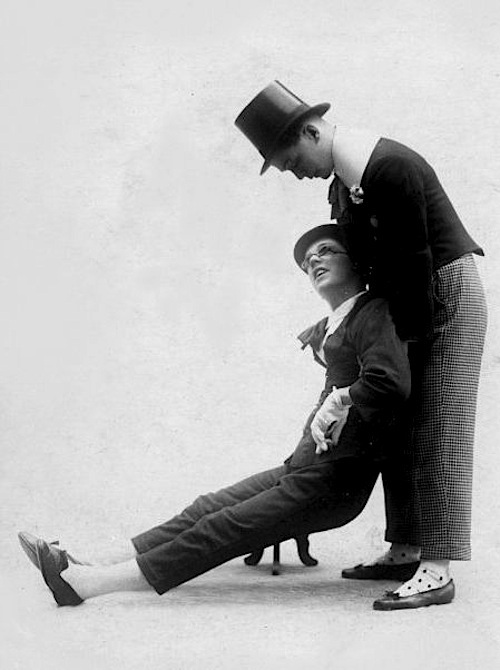
52 years earlier, and In the same year that motion picture films first appeared at the Queen’s Hall in William Street, Perth, the theatre performer and impresario Eric Edgley was born in England with the surname White. Eric and his younger brother Clement developed a song-and-dance routine and went on the vaudeville circuit under stage-names to ‘Edgley’ and ‘Dawe’ (which they claimed came from London street names).
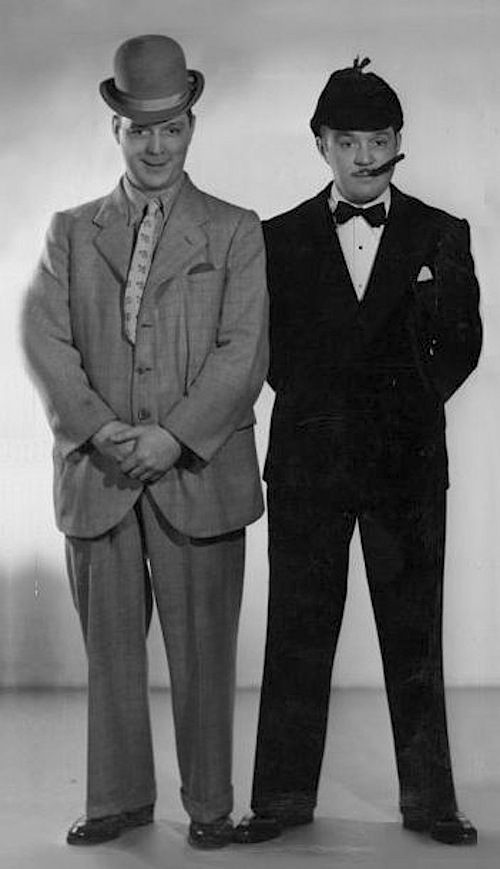
Clem Dawe and Eric Edgley
Clem Dawe and Eric Edgley toured Australasia, the United Kingdom and South Africa, doing shows under various arrangements, and moving from performers to promoters.
They moved to Perth in 1951 to manage His Majesty’s Theatre and bought a seven-year lease of the theatre in 1954, though brother Clem died suddenly in 1955.
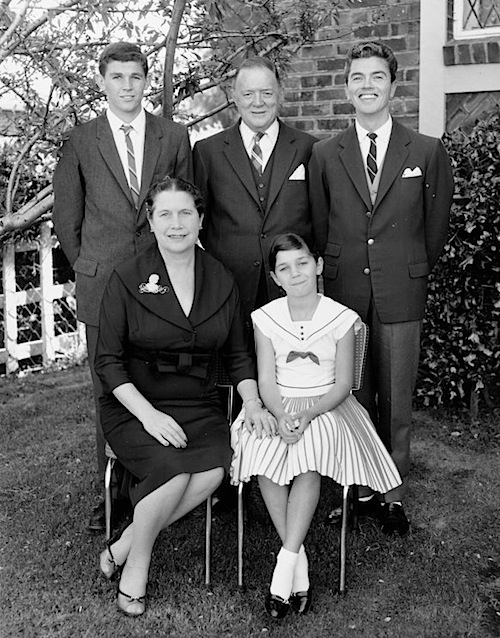
Edgley family Michael, Eric, Phillip, Edna and Christine
Phillip Edgley (1930-1999), was the eldest son of Eric by his first marriage. Phillip’s mother died in childbirth. Phillip was a stage and television performer in Western Australia and an early newsreader with TVW Channel 7 and the host of TVW’s first variety show called Spotlight.
Christine Edgley, who was trained as a classical and modern jazz ballet dancer, had a short acting career before performing as part of an aerial act during the first season of Disney on Parade in Adelaide, but was sadly hurt when the contraption they were hanging from collapsed. In the accident, her pelvis, ankle and hip were broken and the base of her spine was damaged. Eighteen months later she was not only recovered but married the Mexican dancer Dante Palomino. She was to became involved in the organisational side of the family business.
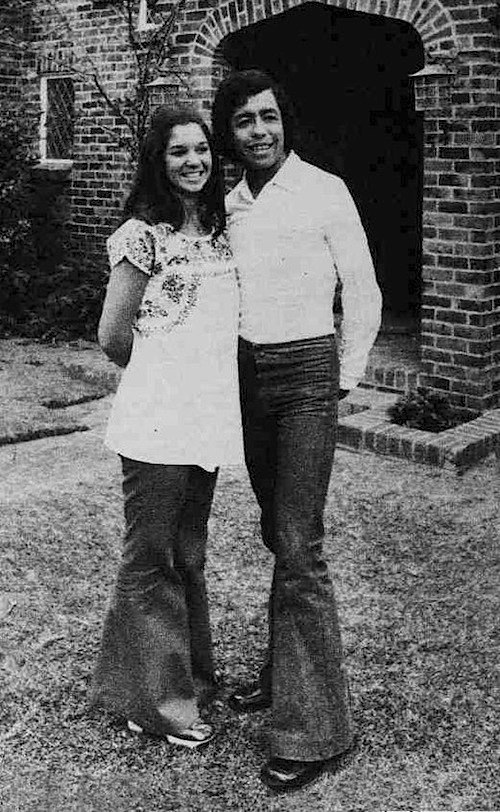
The advent of television in Perth in 1959 caused a slump in theatre attendances until Edgley succeeded in gaining exclusive access and arranging highly successful Australasian tours by the best that the Soviet Union had to offer between 1962 and 1966, with many more to follow. Eric and second wife Edna mortgaged their Perth home to bring out the Moscow Variety Theatre. Edgley presented the Georgian State Dance Company (1963), the Omsk Siberian Dance Company (1964), the Great Moscow Circus (1965), the Berioska Company of Russia (1966) and the Mazowsze Dance Company of Poland (1966).
Interestingly, Eric’s sister Dorothy married the Russian-born violinist Gregory Ivanoff (1884-1965) in 1927. Ivanoff settled in Australia during the First World War. In Australia he regularly appeared on the concert circuit as a virtuoso violinist and conductor of light musical theatre all over the country. He became musical director of the St James Theatre, Sydney, and later moved to Hobart where he broadcast, taught and gave concerts until his death in 1965.
When Eric Edgley died in 1967, his son Michael, at the age of 23, carried on the entrepreneurial business. He presented his first show the next year, a Moscow Circus tour which attracted an audience of 1.2 million and grossed more than $7 million. It was the capital and confidence which resulted from this initial success which launched Edgley into a career as Australia’s most successful entertainment entrepreneur. The family bought the freeholds of His Majesty’s and its adjoining hotel. Though they sold both properties in 1972, they retained a lease on the theatre until 1976.
After successfully managing his company from Perth for many years, Michael moved to Sydney, in order to involve himself in Australia’s fledgling film industry. His first film venture, “The Man From Snowy River”, was a major success, grossing nearly $20 million in Australia, and more than $25 million in the United States. Other film projects include the highly successful “Phar Lap”, as well as II An Indecent Obsession”, “Burke and Wills” and “The Coolangatta Gold”. Michael Edgley has been associated with such renowned attractions as London’s Royal Ballet, the Bolshoi and Kirov Ballet companies, The Royal Shakespeare Company, Marcel Marceau, Torvill and Dean, the Moscow Circus and many more.
When Edna, the matriarch of the family died age 89 in 2000, she was survived by her two children, Michael and Christine, and six grandchildren.
Unfortunately in 2011, Michael Edgley’s decision to dabble in property development during his retirement has overshadowed the successes of the showbiz entrepreneur, when he filed for bankruptcy with debts of $7.3 million. This is not expected to affect his work as a consultant in the entertainment industry, including work for the touring Moscow Circus, which has been owned and operated by other members of the Edgley family and their partners for a number of years. As such, Edgley occasionally returns to the business, working for his son Mark who runs the Moscow Circus. His daughter, Gigi, is an actress.
In 1952, the West Australian Ballet was established by Madame Kira Bousloff to be the first ballet company formed in Australia, and which is still in existence today. The ballet made its first stage appearance 1953 at His Majesty’s Theatre, Perth, with 35 dancers and first major television appearance in Brian Williams’ version of Tchaikovsky’s ballet masterpiece, The Nutcracker in 1963.
Also in 1952, the Graduate Dramatic Society (GRADS), a not for profit theatre production company was established to be a leading source of fine, mostly classic, theatre in Western Australia. Membership of GRADS, was originally for graduates of UWA, but has now been extended to graduates of any tertiary institution, and non-graduate members are welcome as associate members. They present up to three performances per year, with the Dolphin Theatre as the prime venue.
The 1950s was also a time when the American tenor Mario Lanza (1921–1959) whose short career from the late 1940s and the 1950s, covered opera, radio, concerts, recordings, and motion pictures, not only featured in movie musicals but the soundtracks and his other music got considerable air play on Perth radio.
In 1954, the Liberty Theatre was opened in Barrack Street, showing predominantly foreign films.
Perth’s first drive-in theatre the Highway opened in Albany Highway, Bentley. The growth of drive-ins continued into the 1960’s despite the advent of television, which had a big impact on both live and cinema activities.
Then in 1956, the Savoy Theatrette opened in Hay Street showing newsreels and short films. It was located in the basement of the Heritage listed Savoy Hotel, which was built in 1912. The space was originally a billiard hall, and was converted into the Savoy Theatrette in 1956. It operated as a newsreel theatre, also screening short subjects and cartoons, in one hour long programmes. When television arrived, the Savoy Theatrette went over to screening full length feature films from mid-1959. In 1975, the programming policy changed to R-Rated adult films.
The Repertory Club, which become a fully professional theatre company called the National Theatre, following the move to The Playhouse at 3 Pier Street, Perth, on Wednesday 22 August, 1956, after the site of the former Church of England Deanery tennis court was transformed into a live performance theatre.

The Playhouse theatre in Perth was designed by Krantz and Sheldon in 1956
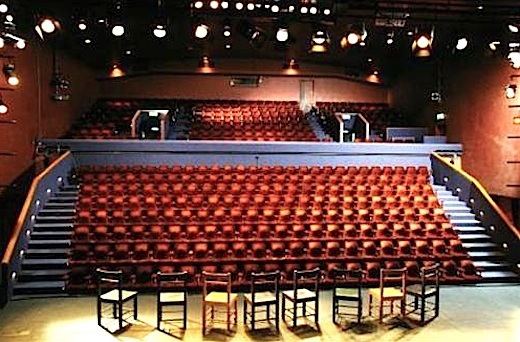
Looking from the Playhouse stage
The Playhouse remained one of the city’s principle venues for performing arts until replaced by the State Theatre Centre of Western Australia in January 2011.
In 1959, TVW Channel 7 opened, providing the first television service in Western Australia. The following year ‘Teenbeat’, initially hosted by David Farr, became TVW’s first Rock ’n’ Roll effort with Brian Prior, Clive Higgins and the Zodiac Allstars. This show was succeeded by Club Seventeen, with Gary Carvolth then Johnny Young and the Strangers.
It was also a time of transition for Harry Bluck (1915-1991) whose band provided music for many of the revues at the Repertory Club, when he became the band leader for Perth’s first TV variety show called “Spotlight”.
Prominent dance teachers of the day were Shirley Halliday, Sharyn Woodhouse and Norma Atkinson. The Ballroom dance fraternity also played a role with the Gilkison and the Wrightson dance studios, who amongst others performed in the 1963 Brian Williams directed dance extravaganza “Invitation to the Dance”. The Repertory Club developed from humble beginnings in 1919 and it was not until the ‘Company of Four’ that WA gained its first professional theatre company of local artists set up after the war by Harold Krantz, Sol Sainken, Lily P. Kavanagh and Nita Pannell. John Birman, the Director of Adult Education was also most helpful. The Repertory Club and the Company of Four evolved into a fully professional theatre company called the National Theatre, following the move to The Playhouse at 3 Pier Street, Perth, on Wednesday 22 August, 1956, after the site of the former Church of England Deanery tennis court was transformed into a live performance theatre. Meanwhile, the local Gilbert and Sullivan Society of Western Australia was established in 1951. Then in 1952, the West Australian Ballet was established by Madame Kira Bousloff to be the first ballet company formed in Australia, and which is still in existence today. The ballet made its first stage appearance 1953 at His Majesty’s Theatre, Perth, with 35 dancers and first major television appearance in Brian Williams version of Tchaikovsky’s ballet masterpiece, The Nutcracker in 1963.
WA’s first television director, Beverly Gledhill was trained by the ABC before joining ATN-7 in Sydney. Both Beverly, Gordon McColl and others attended a one year course at North Sydney Technical College run by husband and wife team Bob and Pat Mondel, who later continued training in this field in the United States. The course involved all operational roles in television and the production of closed circuit TV programs related to other courses at the college, which proved a valuable learning aid. At this time the Sydney ABC television studios were located at Gore Hill, which neighboured the North Sydney Technical College.
Meanwhile, Brian Williams trained in television at Melbourne Technical College and the ABC TV Training School in Sydney. Brian rose rapidly from studio supervisor to producer and director and as the youngest producer/director in Australia at that time, he was responsible for a broad range of productions within the ABC and later at Seven in Perth.
Seven’s first floor manager on the opening night, Frank Evans, attended a very primitive form of training in Perth where cameras were cardboard boxes on a tripod in the absence of real studio equipment. Earlier, Frank Evans was a sound effects officer with the ABC in Perth, skilfully providing the atmosphere to radio drama productions. Most of seven’s staff learnt on the job and only a very few had experience elsewhere in television. In comparison, ABC TV staff in Perth received extensive training at Gore Hill, the headquarters of ABN in Sydney.
Both Lloyd Lawson and Richard Ashton attended a Television Production techniques at the Royal Melbourne Institute of Technology which had a very small television studio equipped with PYE cameras, vision and audio mixers. Lloyd had recently been appointed TVW Production Manager and it was Lloyd who alerted Richard to employment opportunities at Seven in Perth. At that time Richard was producing commercials at GTV9 and HSV7 whilst working for the Noel Paton Advertising Pty Ltd and subsidiary Warwick Advertising Services.
In 1960, ABW Channel 2 began broadcasting. ABC radio and the newly created ABC TV station was now operating from new studios in a purpose built building in Adelaide Terrace, Perth.
Also in 1960, the old Dolphin Theatre came into being at the University of Western Australia. The theatre had been an engineering workshop and was named after the dolphins that frequently played in Matilda Bay. It was a weatherboard building that was demolished after the new Dolphin came into use in 1976. The present Dolphin has a large stage and is well equipped with lighting and sound rigs and a fly tower.
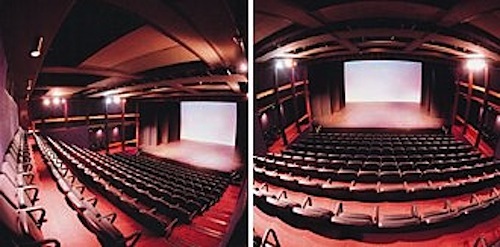
In the 1960s the Lido at Cottesloe was the first cabaret club to feature a stripper and was run by Ron Jenkins, drummer Nutty Cooke, piano Jimmy Beeson and bass player Peter Harrison of ABC fame. It is now a cafe.
6IX became wholly owned by W.A. Newspapers in 1963.
Also in 1963, eight enthusiastic amateurs formed Harbour Theatre in Fremantle. Its first home was the upper floor of the Evans Davies Library in South Terrace and by November 1989 had performed its 100th full length production. In 1995 the group was forced to departed from the Evans Davies Building, and as a temporary measure, Harbour Theatre performed at the Tivoli Theatre, in the suburb of Applecross, for about 18 months until a lease was arranged at the Princess May Building (previously known as the Princess May Girls’ School) Harbour Theatre had always been self sufficient, never having to call on Government or other funding bodies for support. Then in December 2008, Harbour Theatre, in conjunction with many other community theatre’s in WA, were successful in receiving a grant from the Ignite Funding for WA Community Theatre by the Department of Culture and Arts. In December 2009 whey were forced out of the Princess May Building into a temporary venue at the Port Cineaste Building at 70 Adelaide Street, where there is a seating capacity of 117, until a more secure home could be found. Harbour Theatre perform 5 seasons a year with at least 4 full plays and occasionally a season of 1-act plays.
Towards the end of the Capitol Theatre’s life it became a popular venue for Australian and overseas rock stars. Everyone from Gene Pitney, Gerry and the Pacemakers and Dusty Springfield in 1964, the Rolling Stones, Dave Clark Five, The Seekers and The National Bandstand Tour in 1965 with Max Merritt and the Meteors, Lynne Randell, Jade Hurley, Ray Brown and the Whispers, Merv Benson, Bryan Davies and Billy Thorpe and the Aztecs, then there was Bob Dylan in 1966 with other popular acts to include Normie Rowe and Johnny Young.
MAX MERRITT &THE METEORS
Recorded by TVW7 OB cameras in the 1960s at the Capitol Theatre in lower William Street, Perth.
How things have changed from the “Bodgies and Widgies” at Scarborough’s Snake Pit at the early Rock ‘n’ Roll venue of the 1950s, to the great Folk revival of the 1960s which began in the late fifties (Bob Dylan, Cat Stevens), the anti-Vietnam War (1962-1975) Protest Songs that crossed genres and included civil rights, the British invasion with the arrival of the Beatles in the 1960s, the peace, music, sex and drugs of Woodstock in 1969, the punk and hip-hop shakeup of the late 1970’s, the US based 24-hour outlet of music videos on MTV and the ABC’s Countdown with Molly Meldrum (1974-1987) pop revolution of the early colour TV period, Perth’s first commercial FM radio station 96FM began broadcasting on 96.1 MHz on August 8, 1980, Heavy Metal erupted 1970-1991, Stadium Rock dazzled 1965-1993 (Queen), then Alternate rock 1980-1994 (Nirvana) and Indie 1980-2007 (Oasis) taking music back to its roots in the clubs and bars.
In 1964, the New Fortune Theatre came into use at the University of Western Australia, which is a unique venue based on the original Fortune Playhouse (London, circa 1600) of Shakespeare’s time. The first production was Hamlet, directed by Jeana Bradley and Philip Parsons, and involving Graduate Dramatic Society members.

The New Fortune is an ideal venue for reproducing Shakespearean-era plays in their unique performance space. Located within the Faculty of Arts, Humanities and Social Sciences, the theatre also makes a unique setting for dance, drama and music. It can seat up to 508 patrons on four levels around the stage.
In 1965, STW Channel 9 in Perth begins transmissions. Early STW local shows included “All My Eye and Betty Martin Too”, “The Jeff Newman Show” with Ron Blaskett as producer, “Anything Goes” (not to be confused with the Peter Dean and John Fryer show of they same name on TVW), “Peter Harries Presents”, “Tonight with Don Spencer” which had Bruce Allan doing his famous mime act.
Lloyd Lawson moved to STW in 1966, where he read the news and presented a woman’s program called ‘Roundabout’. Audrey Barnaby joined Lloyd on the program at the beginning of 1966, co-hosting with Veronica Overton.
Lloyd became a household name and Western Australia’s first television star, owing to the reaction of viewers at that time. He was recognised for his rich, resonant and eloquent voice and people treated his personal appearances as significant events.
Veronica Overton became a regular face on STW Channel 9 and a household name after appearing on the Channel Niners Club children’s program with Peter Harries, Peter Piccini, Useless Eustance (Alan Graham the station Newsreader), Ron Blaskett and Gerry Gee. Veronica Overton also produced the Breakfast Show with Tim Connor, prepared invitations for the Women’s and Children’s shows, appeared on the afternoon women’s programs, presented the ‘Weather’ each week-night, appeared on the The Tonight Shows and did voice-over presentations in the announcer’s booth. When Veronica left STW, Jenny Clemesha took over many of her presenting roles.
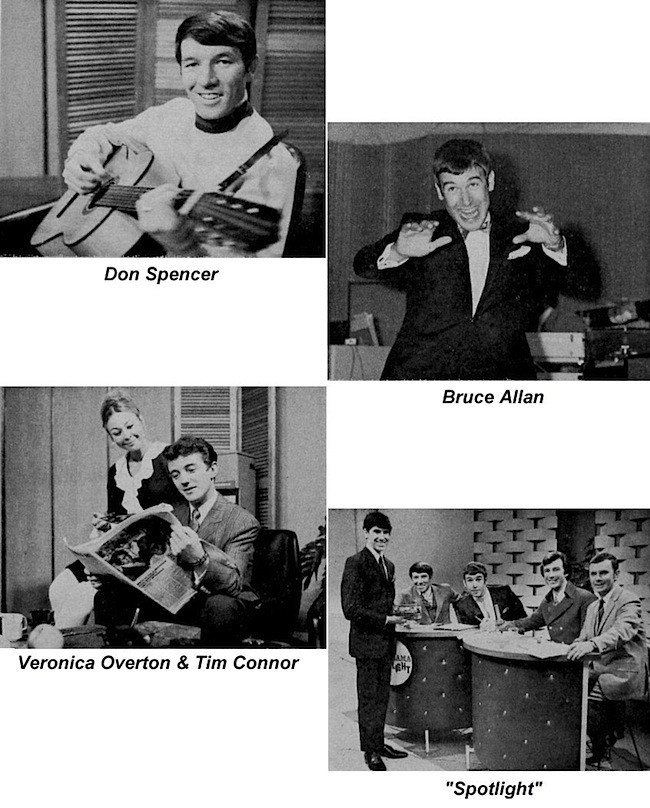
Early STW on-air talent
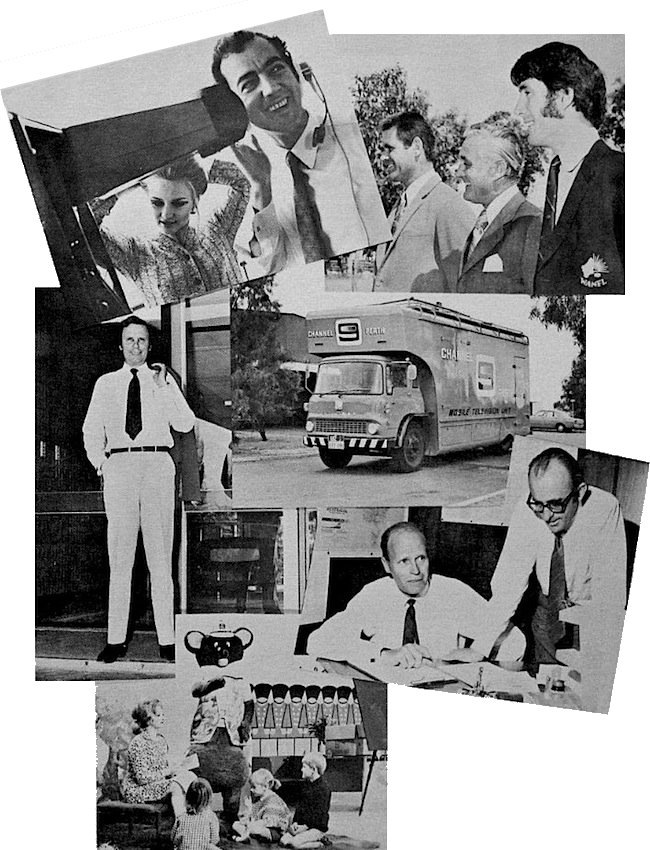
Top left: Jenny Clemesha and Trevor Sutton
In 1969, The Octagon Theatre was opened within the grounds of the University of Western Australia. The Octagon is an intimate thrust stage venue which has hosted opera, classical and popular music, dance, theatre, stand-up comedy and seminars. Versatility is the feature of The Octagon with stage extensions increasing width to 12 metres or the removal of the thrust stage to allow installation of 100 additional seats. Removing half the stage reveals an orchestra pit.

Though television was making a big impact on cinemas and live entertainment, during the 1960s and 1970s, Channel Seven and Michael Edgley were cross promoting everything from the Great Moscow Circus, the Bolshoi Ballet to Disney On Parade. At His Majesty’s Theatre, in the big tent or at the Perth Entertainment Centre. Cross promotion also promoted talent appearing in Perth nightclubs, and by arrangement, it gave the TV stations a good source of talent for their variety shows
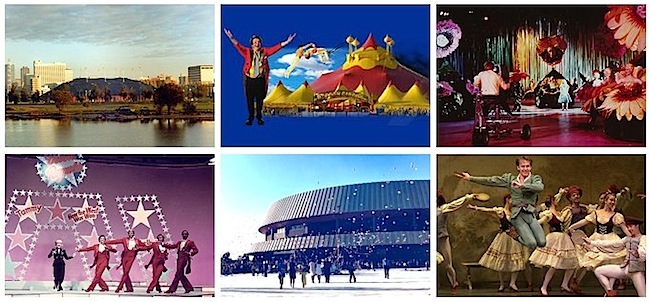
Entertainers from far and wide were appearing on ‘In Perth Tonight’ and at popular nightclubs like La Tenda. ‘Club 7 Teen’ and Johnny Young had guest performers and promoted the local bands, which appeared at the Embassy, Canterbury Court or any number of popular venues. Seven and Nine conducted a number of talent quests from ‘Perth’s New Faces’, ‘The Entertainers’ to ‘Stars of the Future’ and ‘Young Entertainers’. Radio also did an excellent job promoting all manner of local attractions, often supported by competitions and other forms of public involvement.
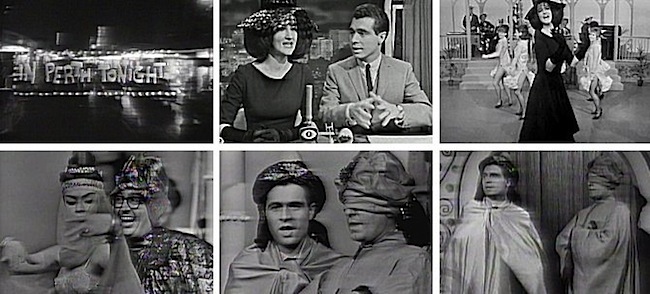
6PM was sold to Sir Frank Packer and the Whitford Broadcasting Network was renamed Consolidated Broadcasting System (CBS).
Between 1850 and 1960 in Britain there existed a popular form of theatrical entertainment called Music Hall which was similar to American vaudeville, and involved a mixture of popular song, comedy, speciality acts and variety entertainment. This concept was revived in Perth in 1967 when Coralie Condon joined with Frank Baden-Powell to open the Old Time Music Hall. This started up initially in the former Braile Hall on the corner of Stirling and Newcastle Streets in Perth and then presented on a grander scale in Fremantle, before settling into the Civic Theatre Restaurant in Beaufort Street. The theatre restaurant notion proved popular, leading to Diamond Lil’s and then the Island Trader. In 1970 they opened Dirty Dick’s Elizabethan Room, which spread nation wide, with premises in Sydney, Melbourne, Adelaide, Brisbane, Canberra and several regional centres. At one time there was even a Dirty Dick’s in Los Angeles. The theatre group also toured extensively throughout the country with a selection of about fifteen shows.
In 1972, Peter Harries with entertainment partner Kelly Green, business partner Gavin Worth, and his many friends opened up the the Knight Klub Night Club in Como, with its colourful and high spirited floorshows.
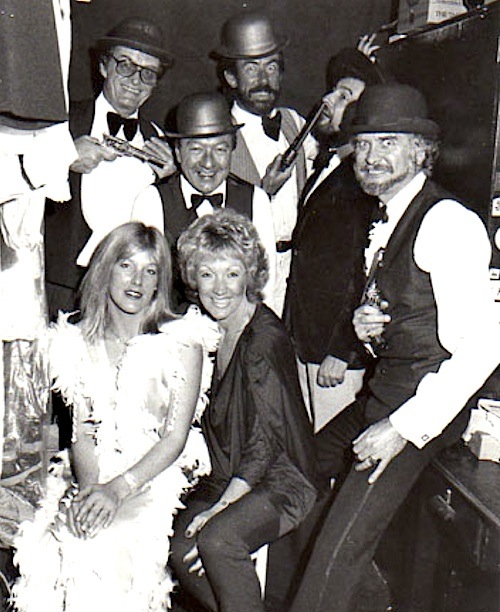
In 1976 Max Kay opened his incarnation of the Civic Theatre Restaurant where he wrote, produced and performed in his own shows. The “Five past Nine” shows as they were called, incorporated a unique blend of singing, dancing and sketch comedy (which gave birth to some favourite characters, including the World War II Japanese Officer “Colonel Itchy Knackers” “Rhamet Upya” the Pakistani Immigrant, “Luigi Savadamoni”, and many others). The Civic Theatre was a successful Perth icon, for 25 years, playing to over 1.5 million people, and employing up to 100 people during the busy seasons including stage performers, stage technicians, administration and sales staff and food and beverage staff.
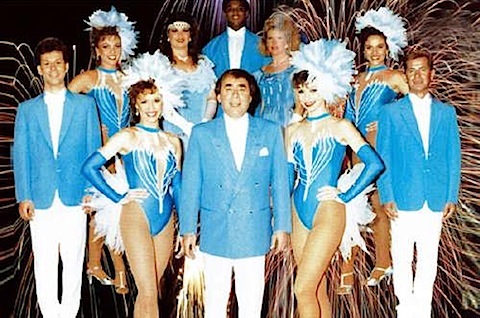
Peter Harries points out that the Burswood casino, theatre and club complex killed off all the traditional cabaret clubs in Perth.
Richard Ashton provided much input and guidance in the compilation of this essay, Gordon McColl assisted in field trips and library research with Richard. Also appreciate the help provided by Dr Peter Harries, and Ian Stimson. Conversations with Coralie Condon, Audrey Long and Rick Hearder are highly valued, as they reminisced about the topic.
INDEX: Factors that moulded entertainment in Perth







